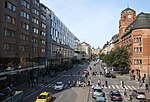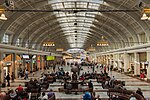Central Post Office Building, Stockholm
Art Nouveau architecture in StockholmGovernment buildings in SwedenListed buildings in StockholmPost office buildings

The Central Post Office Building (Swedish: Centralposthuset or Centralposten) is a historical building at 28-34 Vasagatan in central Stockholm, Sweden. Inaugurated in 1903 and designed by architect Ferdinand Boberg (1860–1945), the building was the headquarters of Posten (Swedish post services) until 2003. It is currently serving as offices for the Ministry of Enterprise and some functions of the Government Offices, after an extensive rebuild in April 2008.
Excerpt from the Wikipedia article Central Post Office Building, Stockholm (License: CC BY-SA 3.0, Authors, Images).Central Post Office Building, Stockholm
Bryggargatan, Stockholm Norrmalm (Norrmalms stadsdelsområde)
Geographical coordinates (GPS) Address External links Nearby Places Show on map
Geographical coordinates (GPS)
| Latitude | Longitude |
|---|---|
| N 59.3323 ° | E 18.0582 ° |
Address
Centralposthuset
Bryggargatan
111 20 Stockholm, Norrmalm (Norrmalms stadsdelsområde)
Sweden
Open on Google Maps









